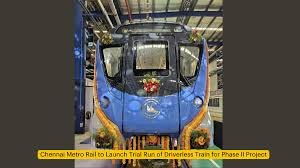Chennai Metro Rail: Trial Run of Driverless Train for Phase II Project
Chennai Metro Rail Limited (CMRL) is set to revolutionize urban transportation with the upcoming trial run of its first-ever driverless train. Scheduled for October 22, 2024, this significant milestone marks the transition of the Chennai Metro into a new era of automated operations. This initiative aligns with the government’s vision of enhancing public transportation while ensuring safety and efficiency for commuters.
Importance of the Driverless Train System
The introduction of the driverless train system is expected to streamline operations and improve safety. With advanced technologies such as Automatic Train Operation (ATO) and Automatic Train Protection (ATP), these trains can autonomously handle the train’s speed, braking, and stopping without human intervention. The deployment of driverless technology also allows for higher frequency and reliability of services, catering to the growing urban population’s needs.
Benefits of Phase II Expansion
The Phase II project of the Chennai Metro will add 118.9 km to the existing network, significantly enhancing connectivity across the city. This expansion aims to connect key areas, including suburban regions, educational institutions, and business hubs. By increasing the metro’s reach, the government intends to promote public transport usage, reduce traffic congestion, and lower carbon emissions, contributing to a sustainable urban environment.
Safety Measures and Training
As part of the trial run preparations, CMRL has emphasized rigorous safety protocols. Comprehensive training programs for staff and emergency response teams will ensure readiness for any situation. Additionally, the implementation of a robust signaling system will help maintain the trains’ safety and operational integrity during the trial phase.
Future Prospects
The successful trial of the driverless train is just the beginning of a transformative journey for the Chennai Metro. Once fully operational, the automated trains are anticipated to provide a seamless travel experience for commuters. The integration of modern technology into the transportation sector is expected to set a precedent for other cities in India, paving the way for further advancements in metro rail systems nationwide.

Why This News is Important
Enhancing Urban Mobility
The introduction of driverless trains in Chennai is a landmark event in the city’s transport sector. It reflects a commitment to adopting cutting-edge technologies that can drastically enhance urban mobility. As cities worldwide shift towards automation, Chennai’s initiative ensures that it remains competitive in the global urban landscape.
Addressing Traffic Congestion
Chennai faces significant traffic congestion due to its growing population and increasing number of vehicles on the roads. The trial run of driverless trains represents a strategic move to mitigate this issue. By providing a reliable alternative to road transport, the metro system can help decongest the city, reducing travel times for commuters.
Promoting Sustainability
The government’s focus on expanding the metro network with driverless technology aligns with sustainable development goals. By encouraging the use of public transport over personal vehicles, the initiative supports environmental conservation efforts. This is crucial for cities grappling with pollution and climate change challenges.
Improving Safety Standards
The implementation of driverless trains signifies a shift towards safer travel options. With advanced safety systems in place, the likelihood of human error is minimized, ensuring a safer commuting experience for the public. This aspect is vital for building public trust and encouraging metro usage.
Setting a Precedent for Future Projects
The success of the driverless train trial in Chennai may serve as a model for other cities considering similar advancements. It showcases the potential for automation in public transportation and can inspire investments and developments in metro systems across India.
Historical Context
The Chennai Metro Rail project was inaugurated in 2007, aimed at easing the city’s traffic woes and promoting sustainable urban transport. The first phase of the metro was opened to the public in June 2015, covering 45.1 km. The expansion into Phase II, initiated in 2019, aims to further enhance connectivity by integrating suburban areas into the metro network. The transition towards driverless technology is part of a broader global trend, with many cities adopting automated systems to improve efficiency and safety in public transportation.
Key Takeaways from “Chennai Metro Rail: Trial Run of Driverless Train for Phase II Project”
| S.No | Key Takeaway |
|---|---|
| 1 | The trial run for the driverless train is scheduled for October 22, 2024. |
| 2 | The driverless system will utilize Automatic Train Operation (ATO) technology. |
| 3 | Phase II will expand the metro network by 118.9 km, enhancing city connectivity. |
| 4 | Rigorous safety protocols and training programs are being implemented for staff. |
| 5 | The project aims to reduce traffic congestion and promote sustainable urban transport. |
Important FAQs for Students from this News
1. What is the significance of the driverless train trial run in Chennai?
The driverless train trial run represents a major advancement in urban transportation, aiming to improve safety, efficiency, and connectivity in Chennai’s metro system.
2. When is the trial run for the driverless train scheduled?
The trial run is scheduled for October 22, 2024.
3. What technologies are being used in the driverless trains?
The trains will utilize Automatic Train Operation (ATO) and Automatic Train Protection (ATP) technologies to ensure safe and efficient operation.
4. How much will the Phase II expansion add to the Chennai Metro network?
The Phase II expansion will add 118.9 km to the existing metro network.
5. What measures are being implemented to ensure the safety of the driverless trains?
Comprehensive training programs for staff, robust signaling systems, and rigorous safety protocols are being implemented to ensure the safety and reliability of operations.
Some Important Current Affairs Links


















 Exciting News!
Exciting News!  Join Our Telegram Channel Now!
Join Our Telegram Channel Now!
 Join our Telegram channel for a thrilling adventure into the world of daily current affairs.
Join our Telegram channel for a thrilling adventure into the world of daily current affairs. 
 Don’t miss out on the latest updates and insights! Click to join now and be part of the knowledge revolution!
Don’t miss out on the latest updates and insights! Click to join now and be part of the knowledge revolution! 
